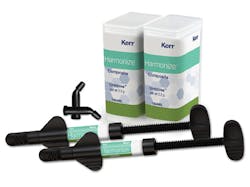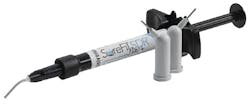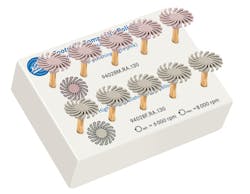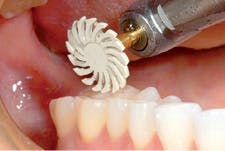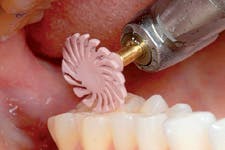Pearls for Your Practice: Universal composite, bulk-fill composite, composite polisher
Harmonize nanohybrid universal composite by Kerr
When I was a junior in dental school, I got invited to a continuing education course put on by a local study club. They brought in Newton Fahl Jr., CD, MS, from Brazil to talk about anterior composites. My mind was blown. I could not believe what I saw. His ability to blend shades and achieve imperceptible restorations with resin composite was breathtaking. I was only in dental school. I thought that was what I had to achieve to be a good practicing dentist. I didn’t know that Dr. Fahl is the Leonardo da Vinci of anterior composites. A few years ago, I saw Dr. Fahl lecture again. Once again, my mind was blown. He is at another level than I will ever be—and not just one other level. He is a hundred levels beyond what I could ever hope to be. I am not a da Vinci with anterior composites. I need help to achieve great results. I need a material that is simple and forgiving to achieve the best results possible. Harmonize by Kerr is both of those things.
Harmonize is a nanohybrid universal composite with the proprietary Adaptive Response Technology (ART) filler system. These nanoparticle fillers help diffuse and reflect light similarly to human enamel, which makes for much better blending between Harmonize and natural tooth structure. The ART filler system helps increase strength and durability as well. Kerr scrutinizes the size and shape of the fillers, which yields higher fracture toughness. Beauty and brawn are both pluses of Harmonize.
Harmonize also handles extremely well. The ART system gives Harmonize “adaptive viscosity,” meaning it is soft during sculpting but won’t slump once sculpting is complete. It also won’t stick to your instrument as much. The result should be less frustration during handling and fewer voids at the surface of the restoration. I like both of those things!
The shading system of Harmonize is fairly simple but provides lots of options to match many different situations. There are three separate translucencies of Harmonize, each of which has a number of shades. The translucency category with the most shades is Enamel, which has 17 shades. The Dentin category has eight shades, and finally, the Translucent category has five shades. These 30 different shades give you countless options to achieve the esthetic result you need. Using these different categories, you can layer restorations or keep them simple with the most universal Enamel shades. The choice is yours.
Harmonize comes in 0.25 g compules or 4 g syringes, and it’s available from most major dental distributors. If you are looking for a universal composite that has the strength and durability to work well in the posterior but the blending, polishability, and handling for anterior success, then Harmonize is a great choice. Solo home run for Kerr!
SureFil SDR Flow+ bulk-fill composite by Dentsply Sirona
Flash back to the summer of 1991. Michael Jordan and the Chicago Bulls had just won their first NBA title. Terminator 2: Judgment Day made Edward Furlong a teenage sensation. And a young Joshua Austin was first introduced to rap music via Ice-T’s album, O.G. Original Gangster. It didn't take 12-year-old Joshua Austin long to figure out what it meant to be an O.G. "Trailblazer" and "pioneer" are synonymous with the term O.G. today. When something is the first of its kind, my generation—with thanks to Ice-T—calls it the O.G.
SureFil SDR Flow+ is the O.G. bulk-fill composite. Never before did we have a resin composite material that would light cure in 4 mm increments. Since this material debuted, the bulk-fill market has blown up. It’s off the chain. You can’t read a dental publication without seeing bulk-fill composites everywhere. They’re all up in that. SureFil SDR Flow+ by Dentsply Sirona (first brought to market by Dentsply Tulsa) started it all and is still a great option today.
When I lecture about restorative dentistry, a significant portion of time is spent on bulk-fill posterior composite materials. People who attend the lectures seem to have equal parts curiosity, interest, and trepidation about these materials. One common complaint I hear is about the esthetics of these materials. There is no doubt that the majority of bulk-fill materials are extremely translucent and gray. It’s part of what allows them to be cured at greater depths. This is a real deal breaker for some people. Another roadblock is that many dentists absolutely love the handling of their composite of choice and can’t bear the thought of using anything else. Both of those barriers can be overcome by SureFil SDR Flow+. SureFil SDR Flow+ allows you to continue to use your go-to composite—you just need less of it!
SureFil SDR Flow+ basically works as your bulk-fill composite base. After your regular etch and bond steps, fill up your prep with SureFil SDR Flow+. Short your SureFil SDR fill by about 2 mm. That 2 mm of space will be filled with what is called a “capping layer" of your composite of choice. This mitigates any esthetic issues. Now you have the esthetics, strength, and handling of your favorite universal composite without having to stack all the increments of it. Less increments mean less time, which means more productivity!
There are some interesting and unique attributes that make SureFil SDR Flow+ very nice. First, its self-leveling property is pretty amazing. Even on a maxillary posterior tooth with the patient reclined, SureFil tends to level itself to the occlusal plane, making it easy to leave enough space for the capping layer. It is also radiopaque, so it looks amazing on bitewings at recall appointments. It adapts to all the nooks and crannies of your preparation, minimizing microgaps within the restoration. And, of course, it is the O.G. bulk-fill material; it can be predictably cured at depths up to 4 mm.
SureFil SDR is still a great choice for posterior resin composite restorations, especially when you want the superior esthetics and handling of a universal composite but still want to take advantage of the reduction of time and steps that bulk fill can offer. It is a great middle ground that gives you plenty of advantages with fewer disadvantages. Line-shot triple to the center-field fence for Dentsply Sirona!
Footsie composite polishers by Komet
We do a lot of direct restorations, much to my chagrin. The majority of headaches I encounter in restorative dentistry are due to resin composite. The real kick in the pants is how much lower reimbursement is on composite restorations compared to ceramic. Part of the headache with composite is that it must be polished in the mouth. We can polish indirect restorations extraorally before we cement them, making it easier to get all of the nooks and crannies. We can’t pop our composite out, polish it up, and then pop it back in, unfortunately. This means we need to find composite polishing products that are quick, easy, and adaptable when it comes to accessing all the areas that need to be polished. Komet’s Footsie composite polishers are all of those things.
Let’s start off with the name—I love it. Bur designations are impossible. Nothing is worse than having to ask an assistant for a certain bur in the middle of a procedure. “I need an 856.016 right away, please!” Meanwhile, the high-volume suction is whirring, and John Mayer is crooning “In the Blood” over the Sonos system. There is no way that my assistant can hear and remember what bur I actually need, and I often end up trying to describe them. “Umm ... I need the skinny barrel that’s rounded, not pointed. No not that one, the other one. No, to your left—your other left.” It’s a mess. I love to be able to say, “Give me the Footsie.”
The name comes from the projections that polish the composite, which resemble feet. This novel spiral shape offers durability and flexibility. It allows you to polish hard-to-reach spots, such as interdental and cervical areas. The durability is important. Footsies can be used and sterilized an average of 10 times before they wear out. That is more economical than the one-and-done polishers that cost more than a dollar each.
Footsies come in two grits, medium and fine. They should be used with a latch-type handpiece between 6,000 and 8,000 rpm with light touch. Starting with a moist surface is preferable to using water spray from the handpiece.
I found Footsies to be great for polishing all different classes of composite restorations. On Class I restorations, Footsies produced a nice polish without obliterating the occlusal anatomy I had created. After polishing a Class V restoration, I remarked to my assistant how well it had polished the restoration without destroying the gingiva. But the best results were on a Class II restoration: the little foot-shaped projections really polished the marginal ridge well without flattening out the embrasures or squaring them off, which can happen easily with some other systems.
Between their durability and great results, Footsies are a winner. Ground-rule double to left field for Komet!

